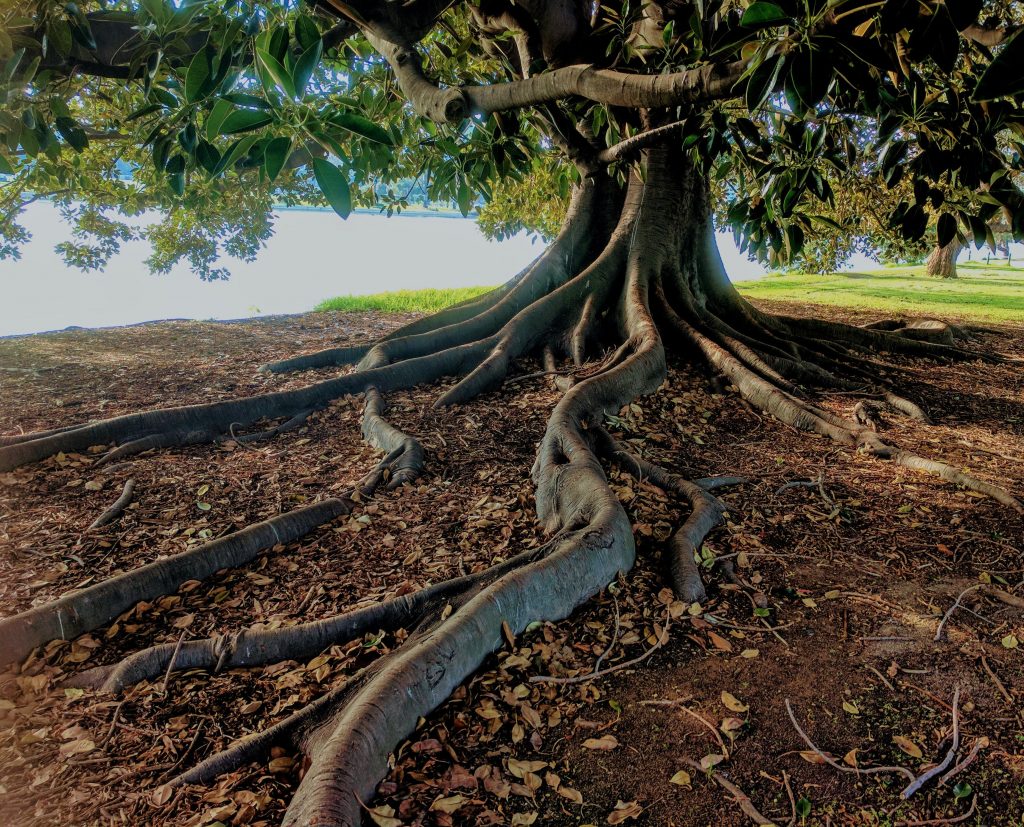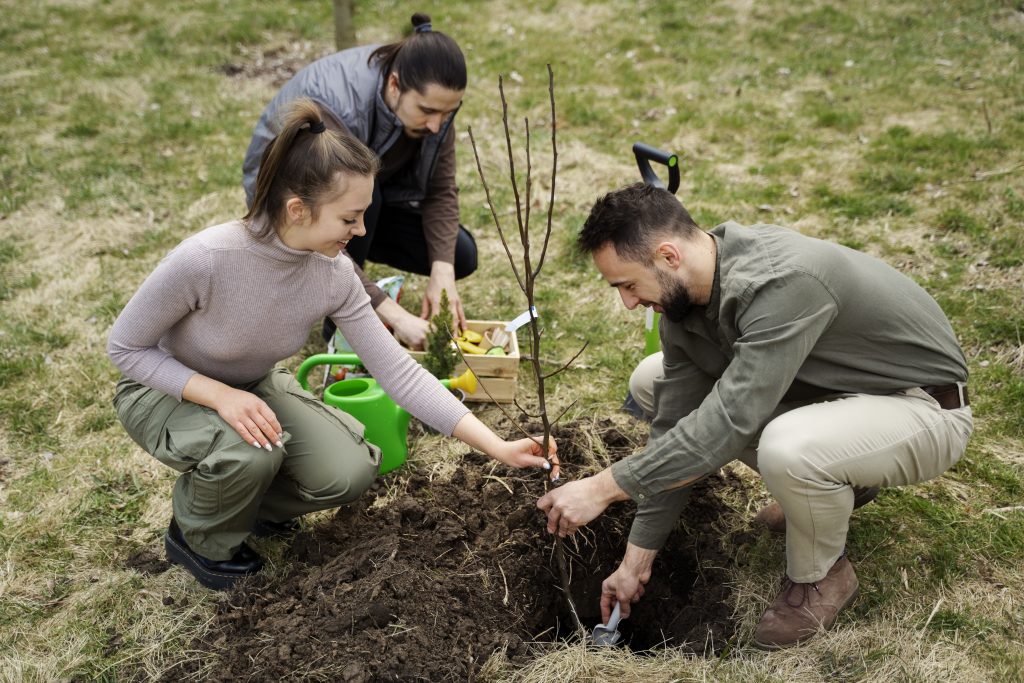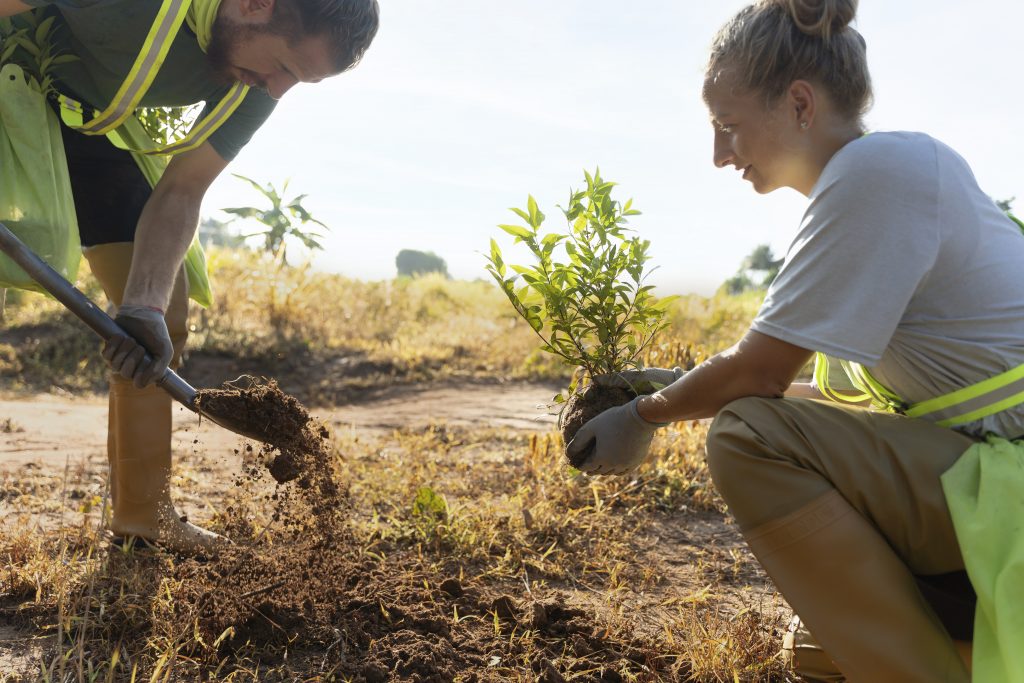THE BENEFITS OF MULCHING AROUND TREES
THE BENEFITS OF MULCHING AROUND TREES
Mulching around trees is a widely recognized and essential practice in both landscaping and gardening. It involves applying a layer of organic or inorganic material over the soil surface within the tree’s root zone. This practice offers a range of benefits that contribute to the health, growth, and overall vitality of trees. Mulching is often considered one of the simplest yet most effective techniques for promoting successful tree establishment and maintenance. Here’s an explanation of mulching around trees as a common practice:
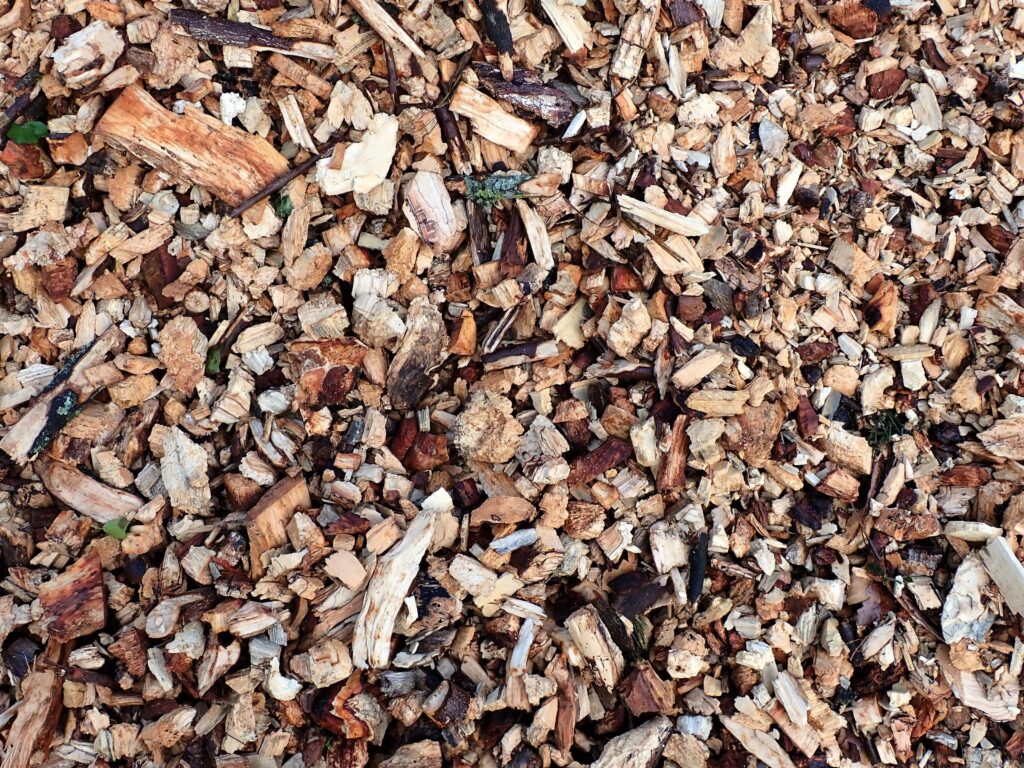
- Soil Health Enhancement:
- Mulching provides a continuous source of organic matter as the mulch material breaks down over time. This enriches the soil with nutrients, improving its fertility and structure. Healthy soil promotes robust root growth and nutrient uptake, benefiting the tree’s overall health.
- Moisture Conservation:
- One of the primary benefits of mulching is its ability to conserve soil moisture. The mulch layer acts as a barrier, reducing water evaporation from the soil surface. This helps maintain adequate soil moisture levels for the tree’s roots, especially during periods of drought.
- Weed Suppression:
- Mulch effectively suppresses the growth of weeds by blocking sunlight from reaching weed seeds and preventing them from germinating. By reducing weed competition, mulching ensures that trees have access to essential resources without competing for water and nutrients.
- Temperature Regulation:
- Mulch acts as an insulating layer, moderating soil temperature fluctuations. In hot weather, it keeps the soil cooler, preventing root stress, while in cold weather, it helps to retain warmth. This temperature regulation supports healthier root activity and growth.
- Erosion Prevention:
- The protective layer of mulch reduces the impact of heavy rainfall on the soil surface, preventing erosion and soil runoff. This is especially important on sloped areas where erosion can expose tree roots and damage the soil structure.
- Root Protection: Mulch acts as a protective barrier, shielding the soil and tree roots from mechanical damage caused by lawnmowers, string trimmers, and foot traffic. This prevents injuries that can lead to root stress and decline.
- Disease Prevention: – By preventing soil-borne pathogens from splashing onto the tree’s lower trunk and foliage during rain or irrigation, mulching reduces the risk of disease infection and improves overall tree health.
- Enhanced Aesthetics: – Mulching creates a neat and uniform appearance around trees, enhancing the overall aesthetics of the landscape. Well-mulched tree beds look tidy and well-maintained.
- Reduced Competition: – The absence of weeds and reduced competition for resources means that trees can focus their energy on healthy growth rather than struggling to establish themselves in a crowded environment.
- Sustainable Practice: – Mulching with organic materials like wood chips or compost promotes the recycling of organic matter, reducing waste and contributing to a more sustainable gardening practice.
- Easy Maintenance: – Mulched areas require less frequent maintenance compared to bare soil or areas with grass. Mulch reduces the need for regular weeding, watering, and soil amendments.
In essence, mulching around trees is a fundamental and valuable practice that offers a multitude of benefits. Its positive impacts on soil health, moisture retention, weed control, temperature moderation, erosion prevention, and overall tree vitality make it an essential technique in both residential and commercial landscapes. By providing these benefits, mulching contributes to the long-term success and beauty of trees while promoting sustainable and eco-friendly landscaping practices.
Mulching is a landscaping and gardening practice that involves covering the soil around trees, plants, shrubs, and other garden beds with a layer of material. This layer serves several purposes, including conserving moisture, improving soil health, controlling weeds, and enhancing the overall appearance of the landscape. Mulching can be done using various organic or inorganic materials, each with its own set of benefits and considerations. Here’s an explanation of what mulching entails and the types of materials used:
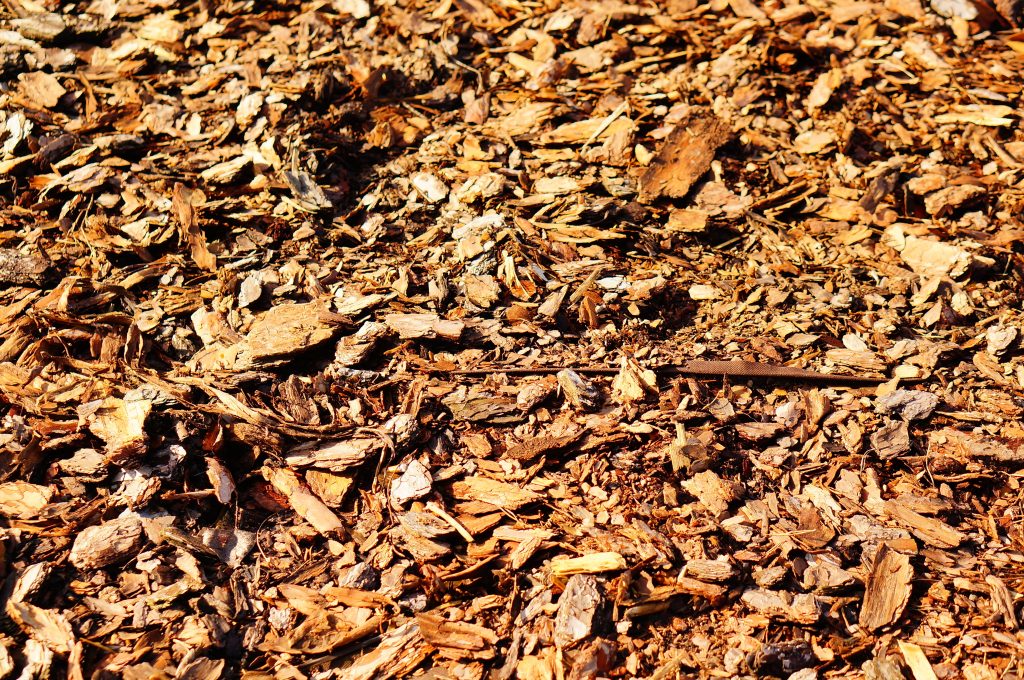
- Organic Mulch:
- Organic mulch consists of natural materials that break down over time, enriching the soil with nutrients. Common types of organic mulch include:
- Wood Chips: Shredded wood or bark from trees and shrubs. They break down slowly, providing long-lasting benefits.
- Straw or Hay: Dried plant stems or grasses that decompose relatively quickly. They’re often used in vegetable gardens.
- Leaves: Collected and shredded leaves from trees, which are rich in nutrients and contribute to soil improvement.
- Compost: Decomposed organic matter that provides nutrients and promotes soil health. It’s particularly beneficial in vegetable gardens.
- Inorganic Mulch:
- Inorganic mulch consists of non-living materials that don’t break down. These materials are often chosen for their durability and appearance. Common types of inorganic mulch include:
- Gravel or Pebbles: Small rocks that provide good drainage and can add a decorative touch to the landscape.
- Rubber Mulch: Recycled rubber products that resemble natural mulch. They don’t break down and can be a sustainable choice.
- Landscape Fabric: Woven or non-woven fabrics placed on the soil before adding mulch. They suppress weeds while allowing water and air to pass through.
- Mulching Process:
- The mulching process involves the following steps:
- Clear the Area: Remove weeds, debris, and grass from the area around the tree or plant.
- Prepare the Soil: Rake the soil to create a smooth surface for mulch application.
- Apply the Mulch: Spread the chosen mulch material evenly around the base of the tree, leaving a gap around the trunk to avoid “mulch volcanoes.”
- Maintain the Depth: Apply mulch to a depth of 2-4 inches (5-10 cm), ensuring it’s not too thick near the trunk.
- Benefits of Mulching:
- Mulching provides numerous benefits, including conserving moisture by reducing water evaporation, improving soil structure and fertility, suppressing weed growth, regulating soil temperature, preventing soil erosion, protecting tree roots from mechanical damage, and enhancing the overall aesthetics of the landscape.
- Considerations:
- When choosing mulch materials, consider factors such as the tree’s water needs, local climate, aesthetic preferences, and available resources. Different materials have varying decomposition rates and nutrient contributions.
In conclusion, mulching is a versatile and beneficial practice that involves covering the soil around trees with organic or inorganic materials. It helps create an environment conducive to healthy plant growth, conserving moisture, enhancing soil health, and reducing maintenance efforts. The choice of mulch material depends on various factors, and proper application ensures optimal benefits for both the trees and the overall landscape.
Improved Soil Health
Mulching plays a vital role in improving soil health by introducing organic matter that gradually breaks down and enriches the soil. As the mulch material decomposes, it provides a range of benefits that contribute to enhanced soil structure, fertility, and microbial activity. Here’s a detailed discussion of how mulching positively impacts soil health:
- Organic Matter Enrichment:
- Organic mulch materials, such as wood chips, leaves, and compost, contain carbon-rich compounds that serve as a valuable source of organic matter for the soil. As the mulch breaks down, these materials release nutrients and organic compounds into the soil.
- Nutrient Release:
- As organic mulch decomposes, nutrients like nitrogen, phosphorus, and potassium are gradually released into the soil. These nutrients are essential for plant growth and contribute to healthier trees and vegetation.
- Soil Structure Enhancement:
- Organic matter from mulch improves soil structure by binding soil particles together and creating aggregates. These aggregates create pore spaces that enhance water infiltration, root penetration, and air circulation within the soil.
- Water Retention:
- Mulch helps the soil retain moisture by reducing water evaporation from the surface. This is particularly beneficial during hot and dry periods, as it ensures a consistent water supply for tree roots.
- Microbial Activity Boost:
- Organic matter from mulch serves as a food source for soil microorganisms, such as bacteria, fungi, and beneficial nematodes. These microorganisms play a crucial role in breaking down organic materials, releasing nutrients, and supporting healthy soil ecosystems.
- pH Buffering: – Organic mulch materials can help buffer soil pH, stabilizing it in a suitable range for plant growth. This is particularly important in soils with pH fluctuations.
- Erosion Prevention: – The layer of mulch protects the soil surface from erosion caused by wind and water. This prevents soil loss and helps maintain a stable soil environment for root development.
- Prevention of Compaction: – Organic mulch creates a cushioning layer that helps prevent soil compaction caused by heavy rainfall or foot traffic. This is especially important for maintaining porous soil for root growth.
- Soil Aeration: – As organic mulch breaks down, it promotes better soil aeration by creating pathways for air to reach the root zone. Well-aerated soil supports root respiration and overall plant health.
- Gradual Nutrient Release: – The slow decomposition of organic mulch ensures a steady release of nutrients over time. This gradual nutrient release aligns with the tree’s growth needs and reduces the risk of nutrient leaching.
In summary, mulching enriches soil health by introducing valuable organic matter that breaks down and offers a host of benefits. From nutrient enrichment and improved soil structure to enhanced microbial activity and water retention, mulching contributes to creating a thriving soil environment for trees and other vegetation. This practice supports long-term plant growth and contributes to sustainable and resilient landscapes.
About Murray, Utah
Murray is a city situated on the Wasatch Front in the core of Salt Lake Valley in the U.S. state of Utah. Named for territorial governor Eli Murray, it is the state's fourteenth largest city. According to the 2020 census, Murray had a population of 50,637. Murray shares borders with Taylorsville, Holladay, South Salt Lake and West Jordan, Utah. Once teeming with heavy industry, Murray's industrial sector now has little trace and has been replaced by major mercantile sectors. Known for its central location in Salt Lake County, Murray has been called the Hub of Salt Lake County. Unlike most of its neighboring communities, Murray operates its own police, fire, power, water, library, and parks and recreation departments and has its own school district. While maintaining many of its own services, Murray has one of the lowest city tax rates in the state.
Neighborhoods in Murray, Utah
Murray Oakes, Grant Park, Southwood Park, Murray Park, Murray Park Restrooms, Willow Pond Park, Neighborhood Veterinary Care
Things To Do in Murray, Utah
Bus Stops in Murray, Utah to Truco Services, Inc.
Bus Stop in Murray Central Station (Bay C) Murray, Utah to Truco Services, Inc.
Bus Stop in State St @ 4801 S Murray, Utah to Truco Services, Inc.
Bus Stop in Murray North Station Murray, Utah to Truco Services, Inc.
Bus Stop in State St @ 4949 S Murray, Utah to Truco Services, Inc.
Bus Stop in Murray Central Frontrunner/Trax Station Murray, Utah to Truco Services, Inc.
Bus Stop in Murray Blvd / Vine St (SB) Murray, Utah to Truco Services, Inc.
Bus Stop in State St @ 3925 S Murray, Utah to Truco Services, Inc.
Bus Stop in State St @ 4824 S Murray, Utah to Truco Services, Inc.
Bus Stop in State St @ 5223 S Murray, Utah to Truco Services, Inc.
Bus Stop in Murray Blvd / Allendale Dr (NB) Murray, Utah to Truco Services, Inc.
Bus Stop in Murray Blvd @ 5039 S Murray, Utah to Truco Services, Inc.
Bus Stop in State St @ 4721 S Murray, Utah to Truco Services, Inc.
Driving Directions in Murray, Utah to Truco Services, Inc.
Driving Directions from Woodruff Tree Trimming and Removal to 4640 Commerce Dr, Murray, UT 84107, USA
Driving Directions from Reliable Tree Care to 4640 Commerce Dr, Murray, UT 84107, USA
Driving Directions from Tree Pro-Tech to 4640 Commerce Dr, Murray, UT 84107, USA
Driving Directions from Prestige Tree And Landscape to 4640 Commerce Dr, Murray, UT 84107, USA
Driving Directions from Excellence Tree & Landscape to 4640 Commerce Dr, Murray, UT 84107, USA
Driving Directions from Amen Trees to 4640 Commerce Dr, Murray, UT 84107, USA
Driving Directions from Tim's Tree Care to 4640 Commerce Dr, Murray, UT 84107, USA
Driving Directions from Jordan Tree Service - Murray to 4640 Commerce Dr, Murray, UT 84107, USA
Driving Directions from Arbor Works to 4640 Commerce Dr, Murray, UT 84107, USA
Driving Directions from Diamond Tree Experts to 4640 Commerce Dr, Murray, UT 84107, USA
Driving Directions from Green Tree Arborist to 4640 Commerce Dr, Murray, UT 84107, USA
Driving Directions from TruCo Services to 4640 Commerce Dr, Murray, UT 84107, USA
Reviews for Truco Services, Inc. Murray, Utah
Emily Abercrombie
We had a great experience with TruCo! They were well priced, responsive and prompt. Michael was a pleasure to work with and gave us advice on which plants to put in where we took out our ugly old shrubs. I would highly recommend this company!!!
Michelle Turpin
TruCo Services gets 5 stars from us for customer service. We experienced a few issues with their services this last year and Rob Eccles in senior management, stepped in and immediately handled our issues. He was very committed to making sure they understood our expectations and would execute to make us happy.
Siobhan Billingsley
I work for a property management company and have the pleasure of working with Rob at a community in Sandy. He has been incredible to work with and always responds in a timely manner. He knows all the homeowners by name and address and is aware of all the "problem" areas when it comes to sprinklers. I never have to worry about following up with him because he always reaches out to provide me with an update. If you're looking to work with someone who takes pride in their job, is professional, and can solve the worst landscaping problems thrown your way, Rob is your guy. Thank you, Rob for all you do!
Jaime S.
We have used Truco at 2 of the complexes we manage, they have been great to work with. Good quality service, outstanding customer service with good communication. That's hard to find these days. I highly recommend them. Travis has been awesome to work with.
Jerusha Smart
We use TruCo for a majority of our properties and our home. While other landscaping companies we use come and go for various reasons like cost, communication issues, work performance, etc., TruCo is always consistent in price and work. Also, Rob is the best.
